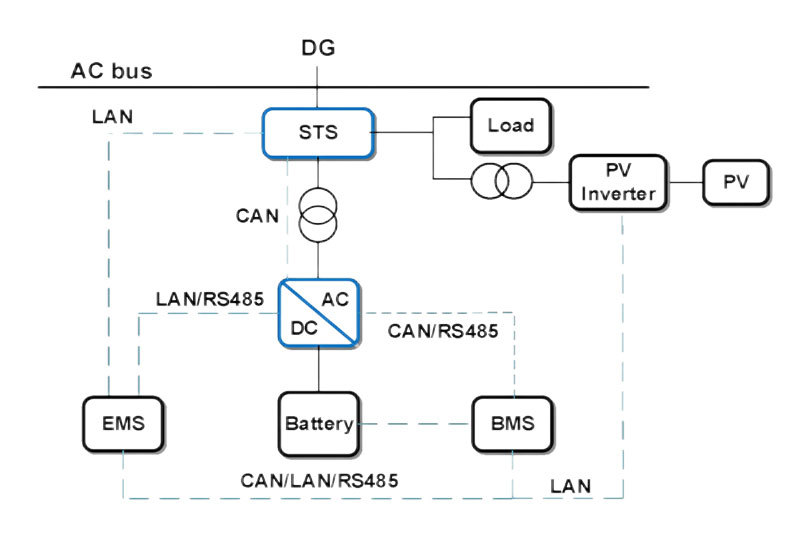Photovoltaic + Energy Storage + DG
System Electrical Principle Diagram Introduction
This electrical principle diagram represents a hybrid energy system that combines photovoltaic (PV) energy, energy storage systems (ESS), and diesel generators (DG) to form a microgrid. The system architecture and key components work as follows:
AC Bus:
The central hub for power distribution in the microgrid, connecting all major components, including the PV inverter, battery, diesel generator, and loads.
STS (Static Transfer Switch):
A key device that seamlessly switches between power sources (e.g., diesel generator and the PV+storage system) to ensure uninterrupted power supply.
PV Inverter:
Converts DC power generated by the photovoltaic panels into AC power for use by the loads or export to the AC bus.
Battery Energy Storage:
Stores excess energy generated by PV systems during the day and supplies power during periods of low solar generation or peak demand.
Diesel Generator (DG):
Serves as a backup power source, kicking in when the renewable and stored energy are insufficient to meet load demands.
EMS (Energy Management System):
Optimizes the operation of the microgrid by managing the flow of power between PV, storage, and the diesel generator based on demand and energy availability.
Communication Interfaces (CAN/LAN/RS485):
Enables data communication between components, ensuring coordinated and efficient operation of the microgrid.
Load Connection:
Represents the devices and equipment drawing power from the microgrid, which can include homes, businesses, or industrial facilities.
This system provides a robust, reliable, and sustainable energy solution, especially in areas with limited grid access or unreliable power supplies.
Expanded Application Directions
This diagram illustrates the integration of photovoltaic (PV) energy storage, diesel generators (DG), and the grid to form a reliable microgrid system. Its application scenarios include:
Remote Area Microgrid Formation:
By coupling PV energy storage and diesel generators, this system creates a stable microgrid capable of providing electricity in regions with limited or no grid access.
Backup Power Supply:
Diesel generators act as a secondary backup when PV energy and battery reserves are insufficient, ensuring continuous power supply during extended periods of low solar generation.
Diesel Generator Replacement:
Over time, PV energy storage reduces the dependency on diesel generators, lowering operational costs and environmental impact.
Improved Load Supply:
The system ensures efficient power distribution to connected loads by balancing PV energy, stored energy, and diesel power.
Flexible Energy Management:
Real-time energy management systems (EMS) optimize the use of renewable and stored energy while reducing the operating time of diesel generators.
For more information,don't hesitate to leave your email and tel and ask for a quotation. We have a professional technical team to provide you with a one-stop energy storage solution!Get a free quotation now!
Enclosure:







